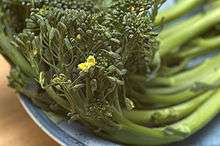Broccolini
| Broccolini | |
|---|---|
 | |
| Scientific classification | |
| Kingdom: | Plantae |
| (unranked): | Angiosperms |
| (unranked): | Eudicots |
| (unranked): | Rosids |
| Order: | Brassicales |
| Family: | Brassicaceae |
| Genus: | Brassica |
| Species: | B. oleracea |
| Cultivar Group | |
|
Brassica oleracea | |


Broccolini (original Japanese: ブロッコリーニ[1]) is a green vegetable similar to broccoli but with smaller florets and longer, thin stalks. It is a natural hybrid of broccoli and kai-lan, both cultivar groups of Brassica oleracea.
History
Broccolini was originally developed over eight years[2] by the Sakata Seed Company of Yokohama, Japan in Salinas, California, United States[3][4] in 1993 as "aspabroc". It was developed as a natural hybrid, in contrast to it being genetically modified.[5]
Sakata partnered with Sanbon Incorporated in 1994 to begin growing commercially in Mexico under the title Asparation, chosen for undertones of Asparagus flavouring. After becoming first available in US Markets in 1996, a 1998 partnership with the Mann Packing Company and Sakata marketed it as Broccollini.[6] In 1999, Broccolini as a registered trademark in Australia was granted to Perfection Fresh Australia by Sakata.[7]
Description
Broccolini has a similar structure to sprouting type broccoli. It grows erect to 80 centimetres, with a slender elongated stem that is 15-30 centimetres long. It is annual or biennial, herbaceous and glabrous.
Consumption
The entire vegetable (leaves, young stems, unopened flower shoots, and flowers) is consumable. Its flavor is sweet, with notes of both broccoli and asparagus,[1] although it is not closely related to the latter.
Common cooking methods include sauteeing, steaming, boiling, and stir frying. According to a 2005 Horticulture Australia study, in Australia 78% of people steam broccolini, 53% stir fry it, and 3% eat it raw or in a salad.[8] It is usually eaten steamed in Japan, where it is highly popular as a spring vegetable.
Nutrition
Broccolini is high in vitamin C (containing 100% of daily intake) and also contains vitamin A, calcium, Vitamin E, folate, Iron, and Potassium.[9] It has 35 calories per serving.

Production
Climate
Broccolini grows in cool climates, and is intolerant to extreme climates. However, it is more sensitive to cold temperatures than broccoli, but less sensitive to hot temperatures than broccoli.[10]
Growth and distribution
It is grown near the central California coast during the spring, summer, and fall seasons and Yuma, Arizona throughout the winter. It takes 50–60 days to grow after being transplanted.[11] It is sold throughout the United States, Canada, and the United Kingdom, as well as 5 states in Australia.
Produce reference
The International Federation for Produce Standards assigns it the price look-up code 3277, "baby broccoli". It is also known as asparation, asparations, bimi, broccoletti, broccolette[12] "Italian Sprouting broccoli",[13] and tenderstem. In the United Kingdom and Ireland it is referred to as "tenderstem broccoli". In Brazil, the common form of the word broccoli ("brócolis") refers to broccolini: the more traditional broccoli is called "brócolis americano" (American broccoli).
References
- 1 2 "朝日新聞グローブ (GLOBE)|サイドストーリー ブロッコリー物語". asahi.com.
- ↑ Chef, Volume 8. 1998. p. 16.
- ↑ "Broccolini (Aspirations)". Speciality Produce. Retrieved 23 September 2016.
- ↑ "Broccoli, Broccolini & Broccoli Rabe". RV Goddess. Retrieved 22 September 2016.
- ↑ "Sakata Home Grown Presents: Broccolini® Ideas". Sakata Vegetables. 1 January 2013. Retrieved 22 September 2016.
- ↑ "Broccolini". Washington State University. Retrieved 17 September 2016.
- ↑ "Broccolini Baby broccoli". Perfection Fresh Australia. Retrieved 17 September 2016.
- ↑ Piccone, Marie. "Understanding the retail performance of broccolini using a tool for determining in store performance and customer demand." (PDF). AusVeg. Horticulture Australia Ltd. Retrieved 17 September 2016.
- ↑ "Broccolini". The Fruits of Life. Retrieved 17 September 2016.
- ↑ Lim, T. K. (2014). Edible Medicinal And Non-Medicinal Plants: Volume 7, Flowers. Springer. p. 625. ISBN 978-94-007-7394-3.
- ↑ "Aspabroc (Hybrid)". Sakata Vegetables. Retrieved 22 September 2016.
- ↑ "Organic Broccolette". Fresh Direct. Retrieved 17 September 2016.
- ↑ "Produce Broccolini". Speciality Produce. Retrieved 15 October 2016.
